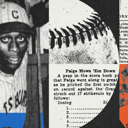The announcement that Major League Baseball is now incorporating statistics from the Negro Leagues into its official database was widely celebrated in and outside of baseball when the news broke Wednesday. Many saw it as a righting of a wrong, a chance to give these players their rightful place in the historical record books of a league that excluded them for decades solely because of the color of their skin.
While well received, the announcement didn’t go as smoothly for me for several reasons. Beyond the obvious fact that these were distinct leagues whose players did not compete in an official capacity, some insinuated that the Negro Leagues and their players were now validated, now that they had the seal of approval from Major League Baseball. This attitude bothered me and continues to make me uncomfortable.
The Negro Leagues don’t need validation. Period. End of sentence. End of paragraph. Their players were some of the greatest in the history of the sport, and to pretend otherwise is as foolish as it is wrong. But a larger concern, beyond the issue of validation, is that incorporating the accomplishments of these players could lessen or distract from the fact that racism was the only reason the Negro Leagues existed. This should never be minimized or forgotten, and I fear it could be.
We live in a time where some believe the Holocaust was a hoax and that the Earth is flat. Some lawmakers and politicians are trying to whitewash this country’s past – or erase part of it altogether – by banning textbooks and certain programs. Is it really a stretch, in this context, to believe that some might use this as an opportunity to rewrite or gloss over the history of why these players were barred from Major League Baseball for so many years? ?

GO FURTHER
Has Satchel Paige thrown more hits than Nolan Ryan? While MLB adds Negro League stats, it’s unclear
The fact is that the further away in time we move, the easier it is to forget the details of what happened – or sometimes even to know that something happened. That’s why I hope baseball takes steps to clearly identify this influx of new players as descendants of the Negro Leagues, which it has yet to do. It’s not enough to simply list Josh Gibson as the career leader in batting average. There should also be something that informs the reader that Gibson was part of the Negro Leagues. Until then, the message remains insufficient when Commissioner Rob Manfred says: “This initiative is intended to ensure that future generations of fans have access to the statistics and milestones of everyone who made the Negro Leagues possible. Their accomplishments on the field will be a gateway to a broader knowledge of this triumph in American history and the path that led to Jackie Robinson’s Dodger debut in 1947.”

Free daily sports updates straight to your inbox. Register
Free daily sports updates straight to your inbox. Register
Buy
Bob Kendrick, president of the Negro Leagues Baseball Museum, fully supports the initiative and what it means for the few Negro Leaguers still alive and the families of those who have passed away. But he also believes that more can be done.
“I want people to know that these players played in the Negro Leagues,” Kendrick told me Friday morning by phone. “I need them to know they played in the Negro Leagues.”

“I hope that through these numbers, through these statistics, that this will be the gateway to wanting to know who these players were,” said Bob Kendrick, president of the Negro Leagues Baseball Museum in Kansas City, Mo. (David Zalubowski/Associated Press)
Not to divide, but to be educational. Kendrick knows that while baseball purists can go to the record book and look up the names of players they don’t know or players who were added later, new fans or casual observers might not be as diligent.
“Twenty years from now, that new baseball fan – white, black, whatever color – I don’t want them to look at this list and not know that once upon a time there was Josh Gibson, Turkey Stearnes or Oscar Charleston. I’m not allowed to play in the ‘white’ major leagues,” he said. “They need to know that there were two separate leagues and ultimately the sacrifices that were made helped bring about change. It’s also about being able to say: this is the story. I hope that through these numbers, through these statistics, it will be the gateway to wanting to know who these players were.
– Negro League Baseball Museum (@NLBMuseumKC) May 29, 2024
Manfred should take a lesson from the early 2000s, when the idea of including Negro League players in the National Baseball Hall of Fame and Museum first surfaced. Some wanted to create a separate wing for these players, as if to say: Yes, we recognize you, but we are not ready to fully welcome you. This created moments of controversy, during which cooler heads prevailed and it was ultimately decided that there would be no separate wing. But one of the things that MLB got right was that they made sure that players’ plaques reflected their time in the Negro Leagues. The same thing should be done with regard to registers.

GO FURTHER
MLB’s integration of Negro League statistics invites us to explore baseball like never before

GO FURTHER
Rosenthal: Inclusion of Negro Leagues Stats in MLB Records Only Improves Baseball History
The entire discussion further reinforces the importance of the Negro Leagues Baseball Museum in Kansas City, Missouri because it is extremely important that black people can not only tell their own stories, but also protect their history. Not to call a particular moment racist, but to show determination and perseverance.
“This story is so triumphant,” Kendrick said. “The circumstances which dictated the necessity of a Negro League are painful and sad. But the Negro Leagues themselves are actually a celebration of the power of the human spirit to persevere and overcome. We cannot lose this history. The life lessons that come from this story of triumph over adversity are more important today than ever, given the things we see in our society.
Yet another reason why Major League Baseball should go further and ensure that its record books contain not only the statistics of these players, but also the origin of the numbers.
(Top photo of Roy Campanella, Don Newcombe and Jackie Robinson, who played in the Negro Leagues before playing for the Dodgers: Bettmann/Getty Images)